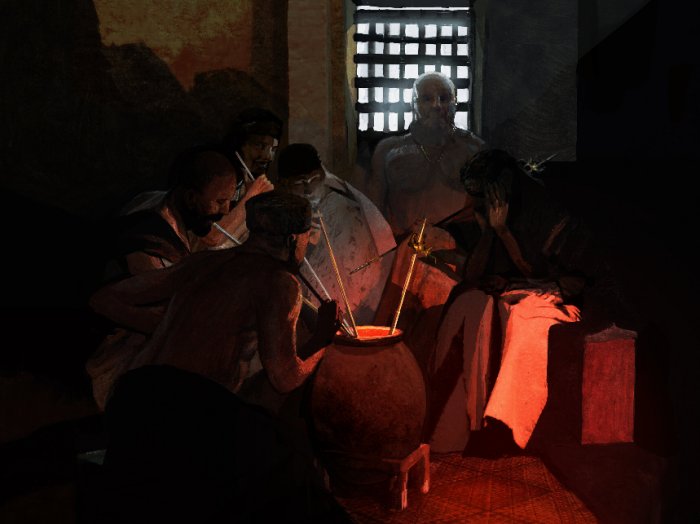Conny Waters – AncientPages.com – The Bronze Age Maikop kurgan is one of the most richly furnished prehistoric burial mounds in the northern Caucasus.
Excavations conducted in the area in 1897, revealed a set of gold and silver tubes with elaborate tips and decorative bull figurines.

Copyright © The Author(s), 2022. Published by Cambridge University Press on behalf of Antiquity Publications Ltd.
Interpretations of these tubes include their use as sceptres and as poles to support a canopy. Re-examination of these objects, however, suggests they were used as tubes for the communal drinking of beer, with integral filters to remove impurities.
If correct, these objects represent the earliest material evidence of drinking through long tubes—a practice that became common during feasts in the third and second millennia BC in the ancient Near East.
Archaeologists have identified the oldest surviving drinking straws. The long silver and gold tubes are over 5,000 years old and were likely used to drink beer from a communal vessel. These were initially found in 1897 in the Maikop Kurgan in the Caucuses. This large burial mound is one of the most famous Bronze Age elite graves from the region, containing three individuals and hundreds of precious objects.

Oldest surviving drinking straws. Copyright © The Author(s), 2022. Published by Cambridge University Press on behalf of Antiquity Publications Ltd.
This included the eight tubes, each over a meter long, some with bull figurines on the stem. Earlier research identified them as scepters or perhaps poles for a canopy. They are now on display in the Hermitage Museum, St Petersburg, but their purpose remained unknown.
As such, new research by a team in Russia, published in Antiquity, re-investigated them.
“A turning point was the discovery of the barley starch granules in the residue from the inner surface of one of the straws. This provided direct material evidence of the tubes from the Maikop kurgan being used for drinking,” said the lead author Dr. Viktor Trifonov from the Insтιтute for the History of Material Culture, Russian Academy of Sciences, St Petersburg.
Specifically, this suggests these straws were used for drinking beer, although the researchers could not confirm that the barley had been fermented.

Left: The design of the ‘sceptre’ components from the Maikop kurgan: 1) one of eight silver perforated tips; 2) joint between two segments of the silver tube, and longitudinal seam; 3–5) types of fittings; 6) probable soldered longitudinal seam (pH๏τographs by V. Trifonov).; Right: Three of eight silver perforated silver tips from the Maikop kurgan: a) enlarged images of the design and slits; b) the silver tips in their original position (pH๏τographs a1–2 by V. Trifonov; b1–3 courtesy of the Insтιтute for the History of Material Culture, Russian Academy of Sciences, St Petersburg, Russia).
Drinking beer through long straws became common practice in the early Mesopotamian civilization of Sumeria from the third millennium BC onward. The art depicts multiple long straws placed in a communal vessel, allowing people standing or sitting nearby to drink together.
During their research, Dr. Trifonov and the team identified several key similarities with such Sumerian straws. Notably, most of them feature metal strainers to filter out the impurities common in ancient beer, something that is also seen in the Maikop straws.
Such similarities with Sumerian finds led the researchers to conclude the Maikop tubes are also drinking straws. “If the interpretation is correct, these fancy devices would be the earliest surviving drinking straws to date,” said Dr. Trifonov, as they are over 5,000 years old.
Given this consistent use of straws with this design for drinking beer from a communal vessel, the researchers concluded that the newly found straws were also likely used in the same way.
Consistent with this, a large vessel was also found in the Maikop Kurgan that could hold enough beer for each of the eight drinkers to have seven pints.

However, this is not the oldest evidence of straws known. Seals from Iran and Iraq dating to the fifth to fourth millennium BC depict people drinking with them from a communal vessel.
Despite these similarities, these new straws are found hundreds of kilometers away from the other early evidence of drinking straw use in Mesopotamia and the surrounding region.
“The finds contribute to a better understanding of the ritual banquets’ early beginnings and drinking culture in hierarchical societies,” said Dr. Trifonov. Such practices must have been important and popular enough to spread between the two regions.
It also sheds light on the culture of Maikop, showing it had deep ties with its neighbors to the south and perhaps a taste for the luxury and spectacle of their drinking ceremonies.
Notably, such ceremonies in ancient Sumeria were often part of ‘royal’ funerals. The inclusion of these straws in the Maikop burial mound and their prized position close to the deceased hints that these lavish burials may have also taken place in the Caucuses.
“Before having done this study, I would never have believed that in the most famous elite burial of the Early Bronze Age Caucasus, the main item would be neither weapons nor jewelry, but a set of precious beer-drinking straws,” said Dr. Trifonov.
Research paper
Written by Conny Waters – AncientPages.com Staff Writer





